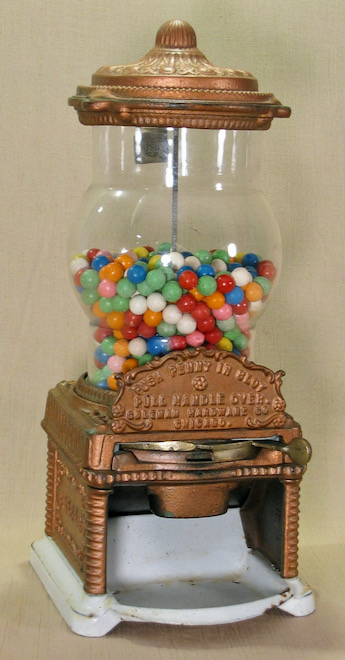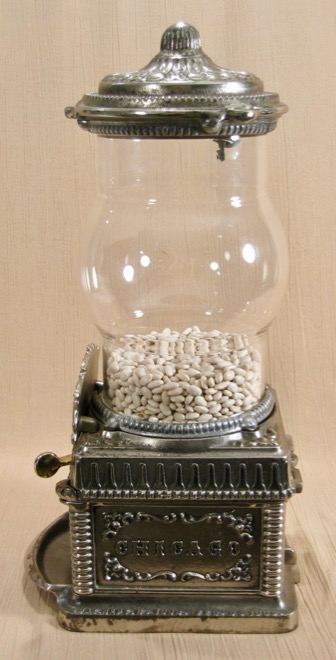___________________________________________________________________________________________
Chicago



___________________________________________________________________________________________



Coleman Hardware Co., Chicago, IL, c. 1908, 19". This is a stunning cast iron 1-cent model from the early 1900's, made to vend peanuts or other bulk product. Made by Coleman Hardware Company and marketed as the "Chicago," Coleman also made the same machine embossed with STAR, SUN, or MORRIS on the sides. You can see the ornate castings above, with a closer view of one side here with the patent date embossed into the base.
This model is not considered rare but it's far from readily available, especially in the conditions shown above. I've been told by knowledgable collectors that some Chicagos are not all original, and presumably this applies to some Star, Sun, and Morris machines since only the branding differs between them. My memory is fuzzy on the details, but the story involves the mechanism and/or vending wheel, which are either entirely reproduced or contain reproduced components that don't work properly. For years I avoided buying one of these models because I lacked confidence that I could evaluate it accurately to confirm that it's all original, such is my perception of the extent of semi-bogus examples out there. And until the plated example pictured above, I never came across one for sale that besmittened me enough to pry the purchase price from my pockets. I bought the plated example from a trusted friend who's an experienced and knowledgable collector familiar with the model, and he vouched for its originality, correctness, and overall superior quality.
After owning that one for several years, I was presented with the opportunity to buy the copper-ish example pictured above left. After learning the history of this particular machine I knew it had never been through a collector's hands so I wasn't concerned about reproduced parts. That story is below. Earlier Chicagos were painted and later examples were plated, but all of the painted examples I'd seen before this one had painted baseplates. The fact that this machine was painted a different color was unusual, and I'd never seen one with a porcelainized baseplate. These two features---especially the porcelainized baseplate---make me think that this is probably one of the earliest examples of this model. Note also that the painted machine has a center rod whereas the plated one doesn't, which---like the porcelainized to painted to plated baseplate---is consistent with the direction I'd expect the model's evolution to have taken if indeed it evolved, which we know it did. The paint is definitely old and I believe it's the original paint, although I'm not sure I could ever prove that sans another example like it showing up. You can see a little more of the side of this machine here and see the rear of it here. Gumballs are not the correct product for this model---in fact, the ones in there now are guillotined in half when you try to vend one---but they were in the machine when I got it and my wife likes 'em in there, so she wins.
This model has a built-in slug rejector, which I didn't know until I stumbled across an ad for the Star Vending Machine on page 285 of Silent Salesmen Too while writing this description. The ad says that the machine "throws out slugs, proof against knife blade or wire." I can't say that's the best-written ad I've ever seen---what's "proof" mean in that context?---but the part about slugs is clear. That sentence fragment follows a preceding sentence further up that says the Star is "far superior to the old style (sic) cheaply made iron machine which can be operated by a wire or knife blade and delivers the contents into a rusty iron cup." That's actually good ad copy, so I'm rethinking my prior comment---but I still don't get the "proof" part. Anyway, I guess that was a problem back then, or at least someone wanted you to think it was and that this far superior model was the solution.
The examples shown above are 100% original except for possibly perhaps the globe on the plated machine, which according to the guy I bought it from may or may not be original; he just didn't know and neither do I. I've never seen a better example of either of these versions.
Okay, now about that painted example....
In the summer of 2021 I got an email with some pictures of the painted machine on the left, asking general questions about what it is and about its value. I arranged to talk to the person who sent the email, who turned out to work for an animal rescue in the midwest. This machine had been donated to them. I donate used clothes and household stuff and electronics I no longer use, others donate exceptional old peanut machines---who's the better person, ya think? The rescue has a little store attached to it where they sell donated items so they can raise money to support their rescue efforts, but they knew this was something special. What they didn't know was how special it was, and needed advice. Was it worth $500 or $10,000?---they had no idea other than one ancient eBay listing they'd found online that offered a nice example of the plated version at a price that was $2000 more than this model sold for at its peak, and market value at the time was down from that peak.
So we talked. I told her about the model in general and its fair market value at the time, and asked questions about this specific machine and its history. One snippet I remember is when I asked her if it worked, she said "Yes, it does, but it cuts the gumball in half." I said "That's because it's a peanut machine, it wasn't made for gumballs." There was a 2-second pause, and she said "Oh."
The machine had been bought by the donor's grandmother about 70 years ago, so around 1950 give or take a few years. Her grandmother had passed it to her daughter---that was the donor's mother---who'd later passed it her daughter, the donor. She's had it for years but for some reason was done with it, and none of her kids or grandkids wanted it.* She'd supported the rescue in the past and thought the proceeds from this would help, so she donated it to them. The machine worked, was complete, and had never been futzed with as far as anyone could remember. I made her a fair offer and she accepted it. Then we worked out the details.
I didn't want her to ship it. The rescue was within a day's round-trip drive from my Indiana house, but I was in Boston and would be there for the next few months so that wouldn't work. I thought of a friend who lived a couple of hours' drive from the rescue, but wanted to burden him with this only as a last resort. So I called my sister, who I thought lived 2 to 3 hours from the rescue and asked her about picking it up for me. Turns out she was planning to drive through the rescue's town in 3 weeks on her way to and from a vacation spot, and she'd be happy to pick it up for me on her way home. Talk about luck! I explained this to the rescue, who said they'd pack it up and pass it to her on that date. I sent them a check so it'd have time to clear before the pick-up, and my sister later picked it up without incident. She took it home with her, kept it boxed in the corner of her garage, and then brought it to me in November when she came to our house for Thanksgiving. It took a roundabout trail to get to me, but it did get to me and that's the key!
* I'm guessing they didn't know what these are worth, or they'd have been a little more interested in it.
___________________________________________________________________________________________
___________________________________________________________________________________________
©Small Vintage Vending 2022